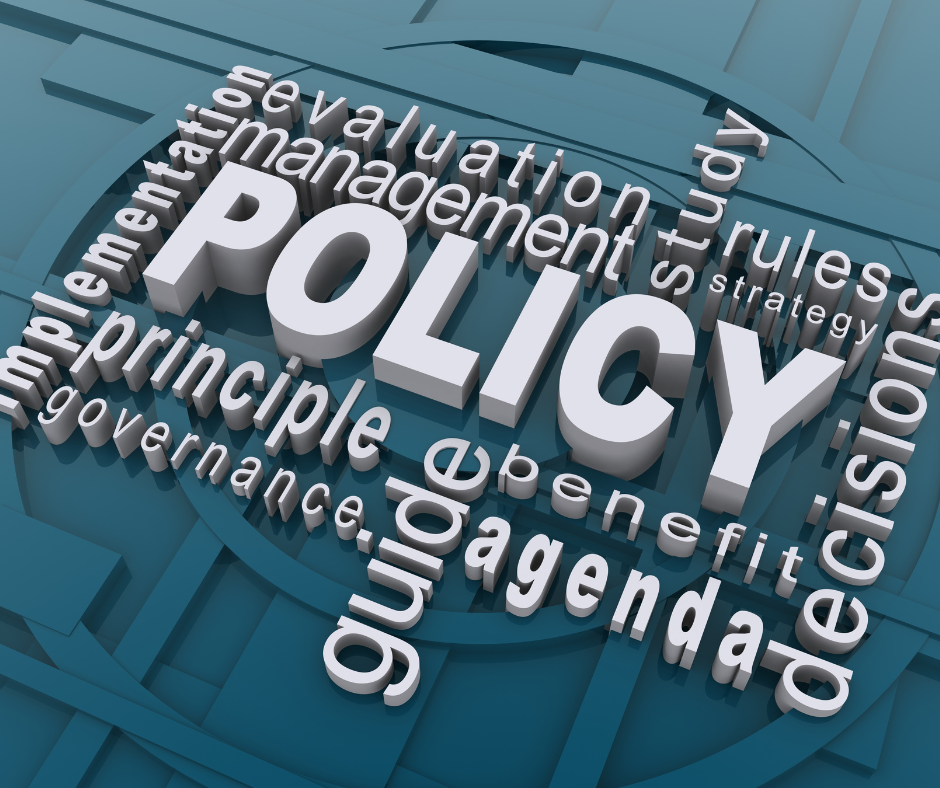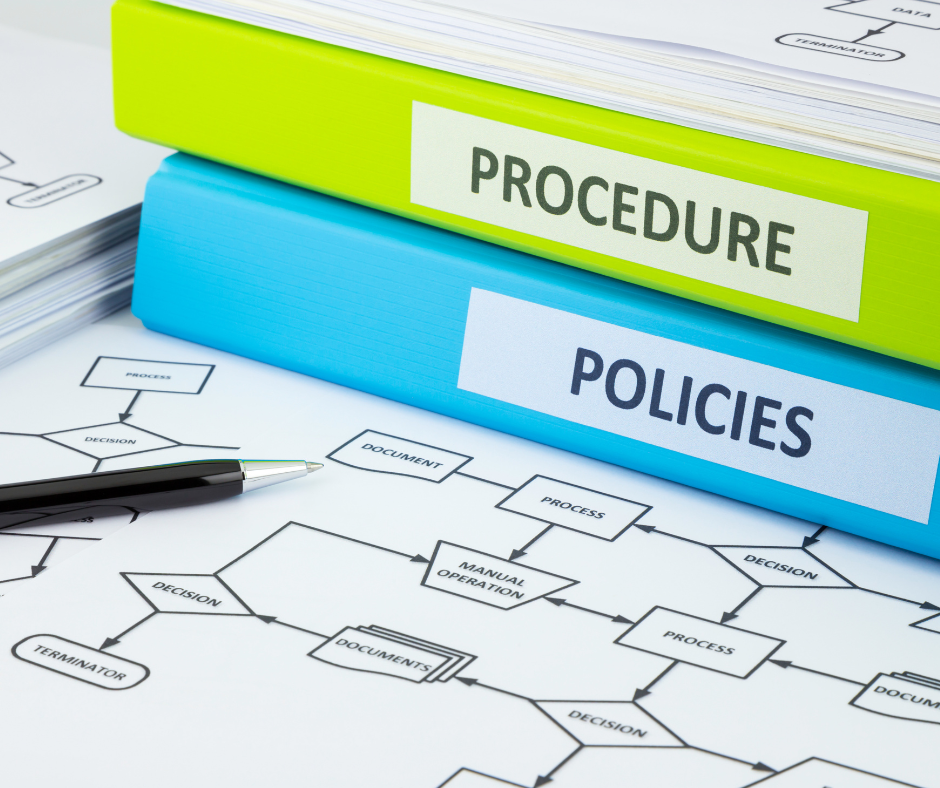
Crafting a perfect policy outline example is an essential skill for organizations that aim to achieve compliance, consistency, and efficiency. It not only helps in ensuring the smooth functioning of your organization, but also contributes to the overall growth and success. So, how can you create such a policy that is easy to understand, implement, and maintain? This blog post will provide you with valuable insights and practical tips to craft an exemplary policy outline that meets your organization’s unique needs and requirements.
Key Takeaways
- Understanding the differences between policies and procedures is key to creating effective policy outlines.
- These outlines should include purpose statements, scope & applicability, responsibilities & accountability, enforcement and consequences.
- Successful implementation of organizational policies requires communication & training as well as regular reviews/updates with centralized access/storage for enhanced security.
Understanding Policy and Procedure Templates
Policies and procedures are the backbone of any organization, providing a clear framework and guidance for employees to follow. Utilizing a policy and procedure template guarantees uniformity across all policies and departments, producing a more professional, consistent aesthetic.
A clear grasp of the differences between policies and procedures is imperative for crafting effective policies that comply with regulations and foster consistency throughout the organization.
Defining Policies
The primary objective of policies is to guarantee worksite safety and supply structure and guidance for an organization. Additionally, they ensure adherence to organizational values and objectives in addition to regulations and standards. A company policy provides structure and guidance for an organization, while a procedure delineates how policies should be executed. For example, an Incident Management Policy and Procedure Template aims to facilitate the reinstatement of vital business operations in the event of process disruptions.
Grasping the difference between a policy and a procedure is key to creating a thorough policy outline. Policies provide the foundation, while procedures offer the specific steps that personnel must take to implement policies proficiently and provide explicit instruction on what to do in certain sets of circumstances. This distinction ensures that your organization’s policies and procedures work seamlessly to achieve the desired outcomes. The procedure describes the necessary actions to follow the policy effectively.
Defining Procedures
As we have established, procedures demonstrate the steps that personnel must take to implement policies proficiently. A comprehensive policy outline should include essential components, such as a purpose statement, scope and applicability, responsibilities and accountability, enforcement, and consequences. For example, the Health and Safety Policy and Procedure Template includes tactics for identifying hazards, assessing risk, and implementing control strategies, often developed in consultation with legal counsel to ensure compliance with relevant laws and regulations.
Supporting documents that can be appended to a procedure include:
- Videos
- Images
- Audio notes
- Forms that require completion
These additional resources help employees better understand existing procedures and perform specific activities efficiently, ensuring consistent adherence to the policy.
Key Elements of a Policy Outline Example
A well-crafted policy outline example consists of key elements, including:
- A purpose statement
- Scope and applicability
- Responsibilities and accountability
- Enforcement
- Consequences
These components work together to effectively communicate the company expectations and guide employee behavior across the entire organization.
Understanding each element’s purpose and function enables policy creators to develop clear, consistent, and actionable policies that are easy to understand, implement, and maintain.
Purpose Statement
The purpose statement serves as a succinct and unambiguous declaration that outlines the overall objective or purpose of a project, organization, or individual. It sets the context for the policy and provides guidance for decision-making and activities.
A concise purpose statement is pivotal in setting the policy’s framework and goals, helping employees comprehend the policy’s reasoning and encouraging them to abide by it. To write a comprehensive and effective policy statement, read our article on examples of company policy statements for some inspiration.

Scope and Applicability
Clearly outlining the scope and applicability of your policy is a fundamental step toward guaranteeing its effectiveness. Here are some key points to consider.
- Scope denotes the magnitude or range of something.
- Applicability denotes the appropriateness or pertinence of something in a given context.
- Delineating the limits and assessing the applicability of the policy ensures that it is applicable to the pertinent stakeholders and circumstances.
Creating a specific scope and applicability allows your policy to be tailored to the unique needs and requirements of your organization. By considering the values, culture, and statutory requirements of the organization, the policy becomes more relevant and actionable for all employees involved. A well-defined scope and applicability ensure that the policy is comprehensive and effective in achieving its intended purpose.
Responsibilities and Accountability
Setting well-defined policy responsibilities and accountability within a policy is a cornerstone for its successful execution. Responsibilities associated with a given role or position refer to the tasks, duties, and obligations that are expected to be fulfilled, while accountability is the obligation to take responsibility for one’s actions, decisions, and performance.
To ensure that the policy remains pertinent regardless of any personnel alterations, refrain from attributing responsibility to a particular individual in policy and procedure documents. Instead, use positions when assigning responsibility. This approach ensures that the document remains relevant and adaptable to changes within the organization, making it easier for employees to understand and follow the policy.
Enforcement and Consequences
Enforcement and consequences form the essential parts of any sample policy outline. Enforcement is the act of ensuring compliance with laws, rules, or policies, which involves the implementation and application of measures to ensure adherence to prescribed standards or regulations.
Consequences, in the context of enforcement, pertain to the outcomes or penalties that result from non-compliance or violation of laws, rules, or policies. These consequences may include:
- fines
- penalties
- legal actions
- loss of privileges
- other disciplinary measures
Establishing clear enforcement measures and consequences for non-compliance with the policy helps ensure that employees understand the importance of adhering to the policy and the potential repercussions for failing to do so.
Customizing Policy Templates for Your Organization
While pre-designed policy and procedure templates can be a great starting point, customizing these templates to fit your organization’s unique needs and requirements is of paramount importance. This customization process involves altering the language, structure, and content of the template to be in accordance with the organization’s policies, procedures, and guidelines.
Customizing your policy template allows for effective communication of your company policy expectations and ensures it aligns with your employees’ understanding.
Identifying Relevant Policies
For effective customization of policy templates, initial identification of the most relevant policies for your organization, considering factors like industry, size, and goals, is a requisite. This process involves examining and evaluating a variety of policies, regulations, and guidelines to identify those that are directly pertinent to the issue in question.
By recognizing and focusing on pertinent policies, you can ensure that your organization’s policy outline is comprehensive and relevant to your specific context.
Adapting Templates to Fit Your Context
Once you have identified the relevant policies, the next step is to adapt the policy templates to fit your organization’s context. This involves customizing pre-existing templates or frameworks to suit your specific needs or requirements. Making modifications, adjustments, or additions to the template allows you to tailor it to better address your specific context and achieve the desired outcome.
For instance, you may need to alter the language used in the template to match your organization’s culture and values, or adjust the structure of the policy to comply with industry-specific regulations. By taking the time to adapt policy templates to your organization’s unique context, you can ensure that your policies are both effective and relevant to your employees and stakeholders.
Tips for Writing Clear and Effective Policies and Procedures
Formulating clear and impactful policies and procedures is pivotal, ensuring that employees comprehend their duties and are capable of making sound decisions. By following best practices, you can create policy and procedure documents that are easy to understand, implement, and maintain.
In this section, we will provide you with valuable tips on writing clear and effective policies and procedures, focusing on language and tone, structure and format, and the review and approval process.
Language and Tone
Using suitable language and tone for your target audience is a paramount aspect of formulating clear and impactful policies and procedures. To achieve this, it is essential to:
- Utilize plain language
- Abstain from technical terminology
- Maintain a consistent tone
- Employ active voice
This approach ensures that your policies and procedures are easily understood by all employees, regardless of their background or expertise.
Employing clear and accessible language in policies promotes employees to read them carefully and minimizes the chances of misinterpretations. Be cautious with industry-specific terms that may carry multiple meanings, as these can lead to confusion among different employee groups. Consulting with the company’s legal counsel can help ensure that the language used is appropriate and clear.
Structure and Format
Successful implementation of policy and procedure documents relies heavily on their organization and formatting for readability and ease of use. It is suggested to utilize the following techniques when organizing and formatting policy and procedure documents:
- Use headings and subheadings to clearly define different sections and topics.
- Use bullet points and numbered lists to break down complex information into easy-to-read points.
- Maintain consistent formatting throughout the document, including font style, font size, and spacing.
- Use clear and concise language to ensure understanding.
- Include relevant visuals, such as tables or diagrams, to enhance comprehension.
By following these basic rules and guidelines, you can create well-organized and easily accessible policy document and procedure documents that promote consistency and clarity within your organization, ensuring that everyone is working from the same document.
A well-structured and formatted policy and procedure document should be easy to navigate, allowing employees to quickly find the information they need. Furthermore, maintaining a consistent structure and format throughout all policy and procedure documents lends authority and credibility to the policies, making them more easily legible and understandable.
Review and Approval Process
The review and approval process serves as a significant step towards verifying the accuracy and effectiveness of your policies and procedures. Involving key stakeholders in the review and approval process guarantees that all pertinent parties have had the possibility to review and contribute input, resulting in a more informed and consensus-based decision-making process.
Establishing a review and approval process for your policies and procedures not only helps to ensure their accuracy and relevance, but also fosters a sense of ownership and buy-in among your employees.
Implementing and Maintaining Your Policies and Procedures
Upon formulating your policies and procedures, their effective implementation and maintenance become indispensable. This involves:
- Communicating and training employees on the new policies
- Conducting regular reviews and updates
- Providing centralized access and storage for your policy documents
In this section, we will explore strategies for successfully implementing and managing your organization’s policies and procedures over time, ensuring that they remain current, relevant, and effective.
Communication and Training
Ensuring that employees understand and adhere to your organization’s policies and procedures necessitates effective communication and training. Regularly communicating any updates or changes to the policies, as well as providing comprehensive training for new employees, helps to guarantee that your workforce is aware of their responsibilities and expectations. Methods of communication and training employed can include:
- Face-to-face meetings
- Online training
- Written materials
- Videos
By investing in thorough communication and training, you can enhance employee comprehension and adherence to your policies and procedures, ultimately resulting in increased productivity and superior customer service. Additionally, a well-informed workforce is more likely to feel confident in their roles, leading to improved morale and job satisfaction.
If you are looking for ways to increase diversity and inclusion within your organization, we recommend going global and hiring international talent. Read our article on effective employee immigration policy for handbook to navigate the legal and administrative aspects of hiring and retaining international talent while ensuring compliance with immigration laws and regulations
Regular Reviews and Updates
To keep your policies and procedures current and relevant, periodic reviews and updates are fundamental. The frequency of reviews will depend on the policy; some may necessitate review every six months, while others may only require review annually or every few years. The review process should involve multiple leaders, providing approval and feedback to optimize the policy, and collaborating on revisions to guarantee that none of the material is lost or inadvertently deleted.
By conducting regular reviews and updates, you can ensure that your organization’s policies and procedures stay up-to-date, applicable, and effective, thereby maintaining alignment with your organizational goals and objectives.
Centralized Access and Storage
For the successful implementation and maintenance of your policies, it’s vital to store policy and procedure documents in a central location for easy access and reference. Centralized access and storage offer several advantages, such as enhanced security, simplified management and control, and effective sharing and collaboration.
Providing centralized access and storage for your policy documents offers several benefits.
- Employees can quickly locate and reference the information they need, ensuring consistent adherence to your organization’s policies and procedures.
- A centralized system facilitates better organization of data and resources.
- It allows for enhanced scalability and flexibility.
Summary
In conclusion, crafting a perfect policy outline example is an essential skill for organizations that strive for compliance, consistency, and efficiency. By understanding the distinctions between policies and procedures, incorporating key elements in your policy outline, customizing templates to fit your organization’s unique needs, and employing best practices for writing and maintaining your policies and procedures, you can create clear, effective, and actionable documents that contribute to your organization’s overall growth and success. Remember, the key to a successful policy is not just its creation, but also its implementation and ongoing maintenance.
Frequently Asked Questions
How do you write a policy outline?
To create a policy outline, define the purpose and scope of the policy, identify responsibilities and procedures, create a standard template, and start writing the policy.
Use a structure with a short title, introduction, policy statement, procedures, and roles. Make sure to identify your goals, brainstorm tasks and processes, determine a policy format, clarify logistics, proofread and revise, and publish and distribute.
What do policies outline?
Policies outline what employees must do or not do, provide direction, set limits and principles, and provide guidance for decision making.
They should be clear, concise, and easy to understand. They should also be regularly reviewed and updated to ensure they remain relevant and effective.
Policies should be communicated to all employees and enforced consistently. This is a very good article.
What is a policy template?
A policy template is a pre-formatted document used to create new Institute policies, ensuring consistency between policies and providing necessary information such as the reason for the policy and the policy statement.
This document helps to ensure that all policies are written in a consistent format and contain all the necessary information. It also helps to ensure that policies are easy to read and understand, making them more effective.
What are the 5 common policy statements?
The five common policy statements are Human Resources, Financial, Legal or Regulatory, Safety, and Operational.
How do you write a policy draft?
To draft a policy, use simple, plain language with relevant details. Check accuracy and compliance while clearly stating who is responsible for carrying out any tasks associated with the policy.
Be concise and keep it general to ensure enforceability.

